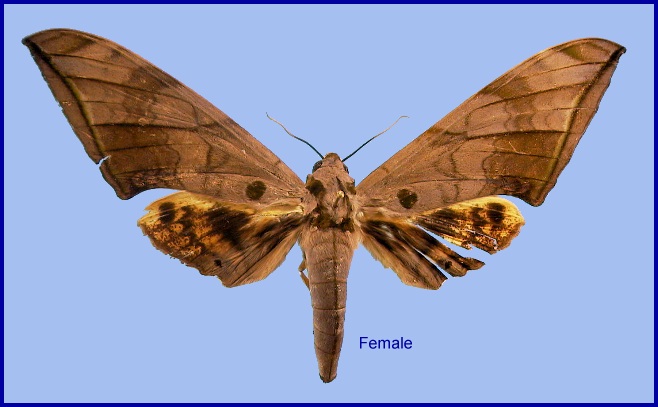
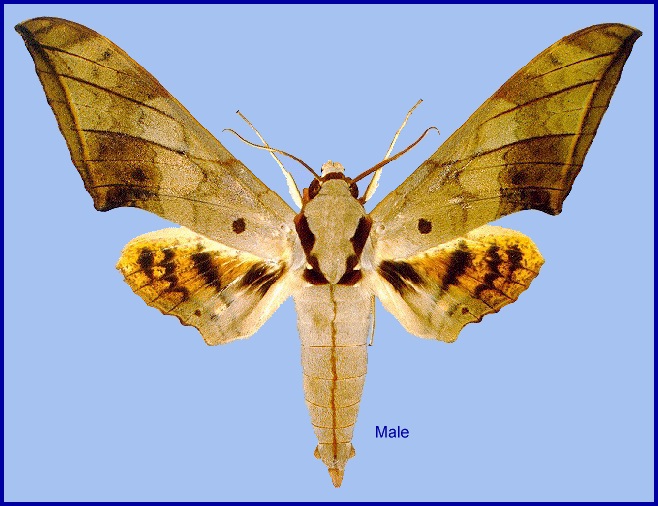
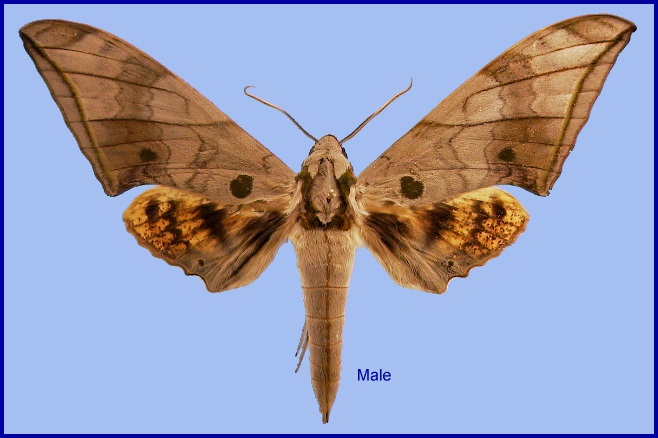
Sphinx (Ambulyx) substrigilis Westwood, 1847, The cabinet of Oriental entomology: [61], pl. 30, fig. 2. Type locality: [Bangladesh,] Sylhet.
Synonym. Ambulyx philemon Boisduval, 1870.
Synonym. Oxyambulyx substrigilis brooksi Clark, 1923.
Synonym. Oxyambulyx sericeipennis subrufescens Clark, 1936.
Synonym. Ambulyx substrigilis cana Gehlen, 1940.
Wingspan: 96--120mm. Resembling Ambulyx liturata in having the basal patch of the hindwing upperside often pale tawny and not conspicuous, but there is more grey on the forewing of the male (as in Ambulyx sericeipennis); the basal patch if the hindwing is less sharply defined in both sexes; forewing upperside usually lacks the sub-basal costal patch, but sometimes it is nearly as large as the spot near the anal margin. The underside of the body, palpi and wings and the upperside of the hindwing is deep orange fulvous. Ambulyx substrigilis comes in two forms, a pale, bright tawny-ochraceous form with a bright orange underside, and a darker, drab form with the markings of the hindwing upperside smaller. It is smaller than Ambulyx pryeri, the submarginal line is more strongly curved inward, and the ground colour of the forewings is yellow rather than brown.
In the male genitalia, harpe with distal process very broad, spoon-shaped, differing markedly from that in Ambyulyx auripennis and Ambulyx pryeri; submesal process longer than in Ambulyx liturata and more erect than in Ambulyx pryeri; and ventral ridge elevated but not denticulate as it is in Ambulyx pryeri. Phallus with apical process short, blunt and curved ventrally, i.e. in the opposite direction from that in Ambulyx pryeri.
In the female genitalia, the vaginal plate characterized by a heavy, irregularly notched ridge in front of the orifice (Bell & Scott, 1937).
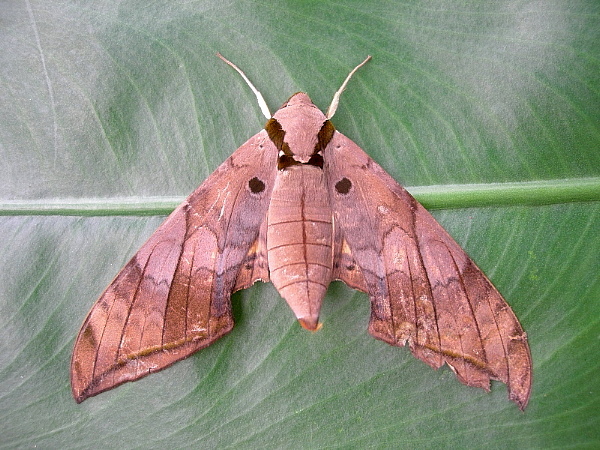
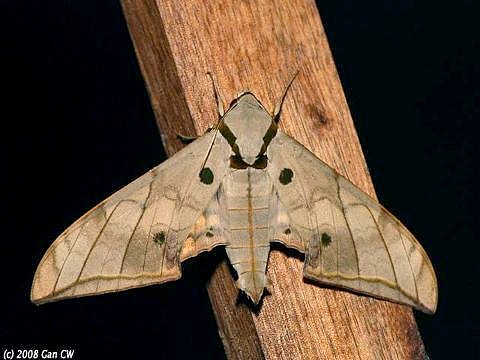
At rest this species prefers to lie horizontal on foliage, particularly on large leaves such as banana. If disturbed, it immediately drops to the ground and lies still.

China: 20.iv (Hainan); vi (Hainan; Yunnan); 26.vii (Yunnan); 28-30.viii (Yunnan).
OVUM: Bright grass-green, slightly oval (1.7 x 2.00mm), shiny but minutely pitted.
LARVA: Full-fed 75mm, breadth 11mm, horn 13 mm. According to Bell & Scott (1937), in the final instar head rounded-triangular; true clypeus one-third length of head, apex acute, basal angles tumid and broadly rounded, giving the clypeus the shape of an ace of spades. False clypeus a rounded arch rising very little above the true clypeus; labrum divided into three sections, the central section four-sided, lateral sections triangular and tumid, the central section again divided by a wide dorsal channel. Ligula four times as long as labrum and as broad as the central section of labrum, shaped like a sausage constricted in the middle. Surface of head shining, covered sparsely with very small, low, round tubercles, with a very small tubercle on the apex of each lobe.
Body of the same shape as that of others of the genus; surface dull. Horn long, straight, tapering evenly to a blunt point. A line of small tubercles starting subdorsally at front margin of segment 2 and becoming dorso-lateral from segment 5 to near base of horn, where it joins the posterior oblique stripe; these tubercles much larger and transversely elongate near the common margins of the segments. Horn covered with very small tubercles; many small shining tubercles on anal flap and claspers.
In colour, head bluish-green in front of a broad white cheek-stripe, bright green behind it; the cheek-stripe edged behind with suffused brown. Labrum glassy-green; ligula pale yellow suffused with brown on the face of each lobe; basal segment of antenna whitish, other segments soiled pale brown; mandible greenish at base, rusty at tip.
Body bright yellowish-green, with encircling rows of small white-spots above the dorso-lateral line of tubercles. Lateral area yellowish-green; subspiracular area and venter glaucous-green suffused with white; the line of tubercles pure white. There are glaucous-white oblique lateral stripes on segments 5 to 11, that on 11 becoming broad and pure white from above the spiracle on 11 and across 12 to base of horn. Horn pale brownish-pink or rose-colour, with the apical third yellowish. True legs pink or rose-colour, the base of each segment narrowly dark brown; prolegs glaucous-green at base, shanks green, ankles pink or rose-colour. Anal flap and claspers yellowish-green. In some specimens the yellowish-green of the dorsum shades gradually into the glaucous-green of the central parts, the line of tubercles being alternately yellowish-green and white. On segments 7-10 the white colour expands into triangular patches below that line; the base and sides of the white triangle may be edged with reddish-brown. Spiracles oval, large, flush, very pale green with the upper and lower ends white, the whole surrounded by a narrow brown rim; those of segments 2 and 12 with a broad, white, central slit.
When alarmed, the larva raises the front part of the body and throws back the head so that the mouth-parts point away from the surface on which it is lying (Bell & Scott, 1937).
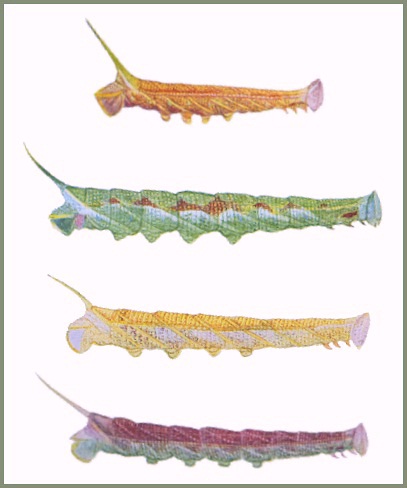
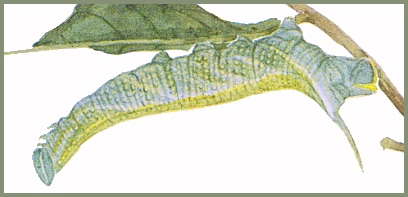
PUPA: 50mm, breadth 12 mm. Colour dark chestnut; spiracles and cremaster black.
Tongue slightly broadening apicad; coxal piece present. Surface shining; tongue smooth, antenna obscurely cross-lined; thorax and abdomen exceptionally rough, with confused corrugation; shoulders tuberculate. Sculpturing on segment 4 as two deep transverse channels on each side of dorsal line, meeting at dorsal line, a raised triangle between each pair. In the remaining abdominal segments the front margin of each is tumid, coarsely pitted and wrinkled, and much darker in colour than the rest of the segment. The rest of each segment also pitted but decreasingly so caudad. Anterior bevels of movable segments 9 to 11 also pitted and wrinkled, posterior bevels paler in colour and minutely lined parallel with the segment margins; hind margin of 11 raised into a ridge. Spiracle of segment 2 much longer than the rest, the central slit enclosed by a raised lobe on each side, one lobe on 2 and the other on 3; the other spiracles large, oval, depressed, the central slit surrounded by a raised edge. Anal clasper-scars somewhat prominent. In the male pupa, in front of these scars on segment 13, the organ-scar circular, mouth-shaped, the depressed line horizontal and occupying three-quarters of 13 posteriorly. Segment 13 is curved forwards and is twice as broad ventrally as it is dorsally. In the female pupa segment 12 is divided by a longitudinal medial line ventrally, and 13 is produced forwards in a triangle into the middle of 12. Cremaster wedge-shaped, triangular when seen from above or below; the upper edge of base of wedge attached to dorsum of segment 14 by a broad, flattened neck. Segment 14 produced ventrad nearly to meet the lower edge of base of wedge, making a transverse perforation. The cremaster narrows suddenly to a blunt tip which is very bluntly bifid; upper surface very rugose and corrugate, under surface deeply and medially channelled (Bell & Scott, 1937).
Larval hostplants. Aglaia littoralis (Meliaceae) in India.
Unknown.
China: Yunnan (Nabanhe Nature Reserve, Xishuangbanna, 1093m; Yexianggu, near Jinghong; Wenshan; Xiajinchang, Malipo County; Tongbiguan Township, Yingjiang County, 1450m; Bapo, Dulongjiang, 1312m); Xizang/Tibet; Guangxi; Hainan (Chengmai; Jianfeng Ling; 924m; Longhushan, Wenchang City; Haikou).
Sri Lanka, India (Subhasish Arandhara, 2016), Nepal, Bhutan (Irungbam & Irungbam, 2019), Bangladesh, Andaman and Nicobar Islands (Singh, Ahmad & Chandra, 2021), Thailand, Vietnam (Le & Vu, 2024), China (Hainan Island), Malaysia (Peninsular, Sarawak), Indonesia (Sumatra, Kalimantan), Philippines.

Map: Distribution of assorted species of Ambulyx from China: Ambulyx substrigilis (purple dotted line); Ambulyx siamensis (ochre squares); Ambulyx liturata (blue dotted line); Ambulyx moorei (red dotted line); Ambulyx canescens (green dotted line); Ambulyx ochracea (yellow patch); Ambulyx maculifera (black triangles); and Ambulyx zhejiangensis (pink triangles). (© Jiang, Kitching, Xu, Xu, Yan, Yu, Liu & Hu, 2025).
 Return to Sphingidae of the Eastern Palaearctic species list
Return to Sphingidae of the Eastern Palaearctic species list